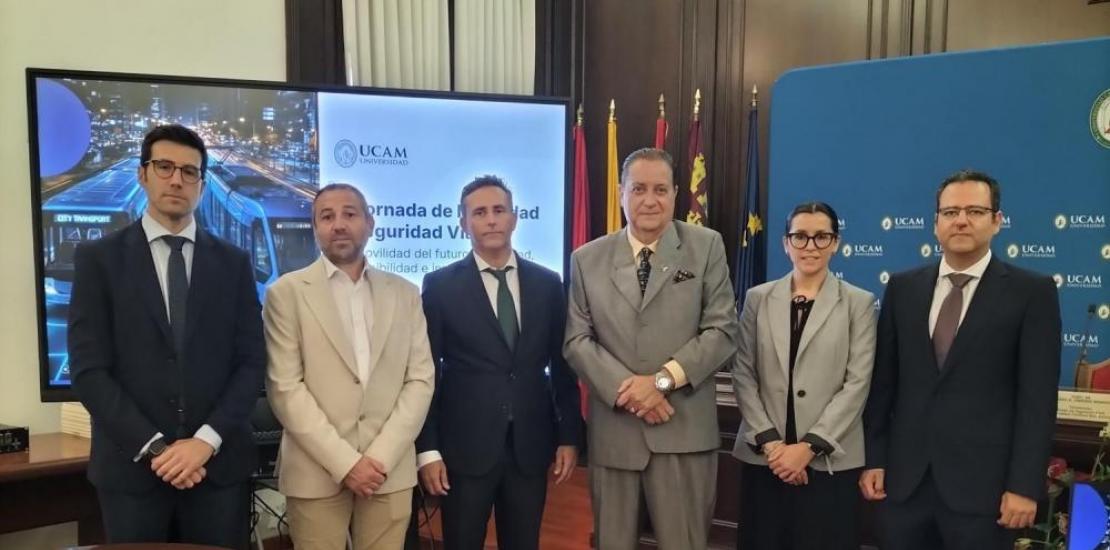Accident rates in urban areas, a blight on road safety
The Director of the Centro de Gestión de Tráfico de Levante (Traffic Management Centre of Eastern Spain) took part in the 10th UCAM Conference on Road Safety and Mobility, presenting some of the DGT's new developments to prevent road accidents.
This morning, the Universidad Católica de Murcia, through its Bachelor's Degree in Civil Engineering, held the 10th UCAM Conference on Road Safety and Mobility, an event already consolidated as a benchmark in the analysis of these areas. This edition focused on safety, sustainability and technological innovation in the mobility of the future. José Antonio Verdú, Director General of Mobility and Transport of the Regional Ministry of Development and Infrastructures of the Autonomous Community of Murcia; Alejandro Lázaro, Dean of the Regional Professional Association of Civil Engineers of Murcia; and Pedro de los Santos Jiménez, Vice-Dean of the CUAM Bachelor's Degree and Director of the Master's Degree in Civil Engineering, inaugurated the conference.
The Vice-Dean of the UCAM Bachelor's Degree in Civil Engineering focused on the persistent problem of road accidents, pointing out that, despite the advances made, ‘the progress in road safety has not been as expected. In 2010 there were 2,500 deaths on Spanish roads and last year closed with nearly 1,700; therefore, we must continue to work on this, and on something that is totally interrelated: mobility’. In this respect, he particularly highlighted the need for improvements in urban areas, since last year there were 12,000 road accidents in Spain, with nearly 300 pedestrians killed. De los Santos pointed to the improvement of technical systems with artificial intelligence as one of the ways to face the future.
Carla Tomás, from Dirección General de Tráfico (DGT, Spanish Traffic Department), acknowledged that, after a few years of lower road accident rates, the figures have stagnated, and therefore pointed out that it will be necessary to take new measures that involve ‘connected mobility using new technologies’, such as Intelligent Transport Systems (ITS), which will improve road safety by keeping users better informed. Among the DGT's projects, she mentioned the ‘connected cone’, a device that geo-references road maintenance and operation work to inform drivers through platforms such as DGT 3.0 or Google Maps, thereby protecting the workers themselves too.
Underuse of public transport in the Region
The situation of mobility in the Region of Murcia has also been discussed as ‘an important challenge in which we have to work together with the Regional Government, companies, citizens and institutions to ensure that this is not a problem’, stated the Director General of Mobility and Transport of the Regional Ministry of Development and Infrastructures of the Autonomous Community of Murcia. He also confirmed the low rate of public transport use in the Region: of nearly 4 million daily journeys by road, only 5% are made by public transport. In this regard, he stressed the need to promote policies to make it more attractive, apply technology to improve traffic flow and, more specifically, the protocol signed with the Murcia City Council to create a more efficient metropolitan transport system.
Lifelong learning
UCAM offers lifelong education in areas such as road safety and mobility, either with the Bachelor's Degree in Civil Engineering, the Official Master's Degree in Civil Engineering, or the UCAM Chair of Sustainable Mobility and Transport, directed by Roberto Liñán, who also took part in the conference. In addition, UCAM offers an Expert Course in Mobility Planning and Management, adding micro-seminars as a novelty, with the participation of leading experts from the sector.




